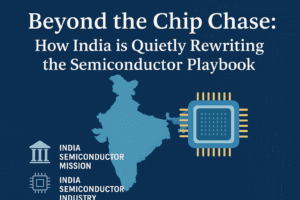Beyond the Chip Chase: How India is Quietly Rewriting the Semiconductor Playbook
India’s semiconductor strategy has pivoted from decades of aspiration to a pragmatic and credible plan focused on supply chain resilience, not full self-reliance. By attracting global anchor firms like Micron and Tata, India is integrating into the global value chain rather than replicating it domestically. This approach mirrors its successful playbook with Apple, leveraging competitive federalism where states like Gujarat lead through ecosystem readiness, not just financial incentives.
While assembly and testing plants are the first visible successes, the critical next phase involves moving from manufacturing to innovation. India must leverage its vast design talent to create intellectual property in high-growth niches like medical tech and wearables. The mission has laid a strong foundation, positioning India as a future strategic partner in a fragmented global industry.

Beyond the Chip Chase: How India is Quietly Rewriting the Semiconductor Playbook
For decades, India’s ambition to become a semiconductor nation was a story of fits and starts—a tale of grand announcements that seldom materialized into concrete progress. The global chip-making industry, with its eye-watering capital demands, razor-thin margins, and need for pristine ecosystems, seemed perpetually out of reach. That story, however, is being rewritten.
A new report from the Carnegie Endowment for International Peace sheds light on this quiet transformation. Since the official launch of the India Semiconductor Mission (ISM) in December 2021, the country has moved from aspirant to credible participant in the global semiconductor value chain. But India’s strategy isn’t the brute-force, go-it-alone approach we’ve seen elsewhere. It’s a more nuanced, pragmatic, and potentially more sustainable game of chess.
A Strategy of Resilience, Not Self-Reliance
The most critical insight from India’s journey so far is a fundamental shift in objective. Unlike China’s heavily state-funded drive for total semiconductor self-sufficiency—an inward-looking model that has faced significant headwinds—India is playing a different game. Its goal isn’t full autonomy but strategic integration.
The ISM has approved ten projects in under four years. These aren’t just paper proposals. They include Tata Electronics’ ambitious ventures and Micron Technology’s crucial assembly, testing, and packaging (ATP) plant in Gujarat. New projects are sprouting in states from Odisha to Punjab.
This isn’t about building a closed, domestic loop. It’s about carving out a vital and resilient link in the global supply chain. By attracting “anchor tenants” like Micron, India incentivizes their entire supplier network to follow, creating a organic cluster of expertise and investment. It’s the same playbook that worked spectacularly with Apple’s manufacturing ecosystem and is now being deployed for Tesla in EVs.
The Real Battleground: State vs. State
While the ISM sets the national vision, the report highlights that the real action is happening at the state level. India’s federal structure has turned semiconductor development into a competitive sport, with states vying to become the nation’s chip hub.
Gujarat has emerged as the early frontrunner, and not just because of attractive financial incentives. Its success is a masterclass in ecosystem development. The state’s dedicated semiconductor policy, combined with the development of the Dholera Special Investment Region (a planned smart city with ready infrastructure), provided the perfect landing pad. Micron’s 2023 investment acted as a powerful catalyst, signaling to other players that Gujarat was serious and ready for business.
This contrasts with other states like Uttar Pradesh and Tamil Nadu, which, despite offering strong financial packages, have sometimes lagged in the less glamorous but more critical areas of execution readiness and ecosystem maturity. The lesson is clear: winning the chip race requires more than a generous chequebook; it requires plug-and-play infrastructure, a skilled talent pipeline, and bureaucratic agility.
The Next Frontier: From “Made in India” to “Designed in India”
Manufacturing and assembly are vital first steps, but they are the middle of the value chain. The real, long-term value lies at the beginning: in design and intellectual property (IP).
India possesses a formidable advantage here—a massive, talented workforce that already designs chips for the world. However, as the report notes, these engineers largely work on specifications set elsewhere. The next phase of the mission must leverage the Design Linked Incentive (DLI) scheme to fuel homegrown innovation.
The opportunity isn’t necessarily in competing directly for the next cutting-edge smartphone processor. Instead, India can focus on becoming a creator of specialized semiconductor solutions for nascent, high-growth fields where it has strong domestic demand and talent:
- Medical diagnostics and portable health devices.
- Tech wearables and personal IoT.
- Neural interface and brain-computer interface technologies.
Excelling in these niches would allow India to move beyond being a workshop for the world and become a laboratory for its future.
The Verdict: Foundation Built, Future in the Making
The Carnegie report concludes that the India Semiconductor Mission has, against the odds, successfully laid the foundation for a resilient semiconductor supply chain. It has done so by adopting a pragmatic, globally integrated strategy and harnessing the competitive federalism of its states.
Challenges undoubtedly remain. Scaling these initial projects, broadening the supplier ecosystem, avoiding bureaucratic delays, and making the leap into advanced design and fabrication will be monumental tasks.
Yet, the trajectory is positive. India is not trying to win the semiconductor race by itself; it is strategically positioning itself to become an indispensable and reliable partner to everyone. In an era of global fragmentation, that may be the most insightful bet of all.
You must be logged in to post a comment.